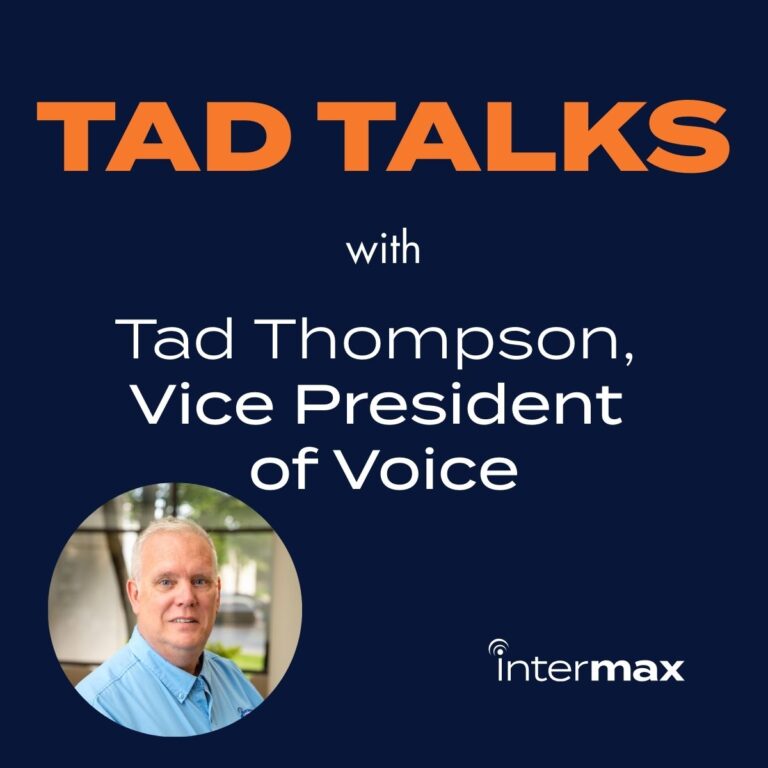
Hosted Voice Glossary of Terms by Intermax
Whether you’re new to voice technology or just need a refresher, we’re here to help. We’ve compiled simple definitions for common terms used in VoIP, cloud communications, business phone systems, and more. From acronyms to industry jargon, you’ll find clear explanations designed to make voice services easier to understand. No tech degree required!
Core Voice & Telephony Terms
PBX (Private Branch Exchange)
The system that manages internal calls and connects to the public phone network. A cloud PBX lives online and doesn’t require on-site hardware.
Telephony
A general term for technologies used to send voice, fax, or data over distances—landlines, mobile, and VoIP all fall under this.
VoIP (Voice over Internet Protocol)
Technology that lets you make calls using the internet instead of a traditional phone line.
Hosted Voice
A cloud-based phone system managed by a provider. No maintenance or on-prem hardware needed.
UCaaS (Unified Communications as a Service)
All-in-one platform that combines phone, video conferencing, messaging, file sharing, and collaboration tools over the internet.
POTS (Plain Old Telephone Service)
Traditional landline telephone service using copper wires—now being phased out in favor of digital options like VoIP.
Technology & Hardware
ATA (Analog Telephone Adapter)
A device that connects a traditional (analog) telephone to a digital VoIP system.
SIP (Session Initiation Protocol)
The tech behind VoIP—it starts, manages, and ends calls over the internet.
SIP Trunking
Connects your traditional PBX to the internet using SIP, allowing you to make VoIP calls while keeping some legacy hardware.
Softphone
A software-based phone used on your computer or mobile device to make VoIP calls.
Mobile App / VoIP App
Use your business phone features on your smartphone—take work calls from anywhere.
BLF (Busy Lamp Field)
An indicator light (usually on a desk phone) that shows whether a coworker’s line is busy or available.
MOH (Music/Message on Hold)
The audio callers hear while waiting on hold—can be music or a custom message.
System Features & Functions
Auto Attendant
A virtual receptionist that greets callers and routes them to the right department or person.
Call Forwarding
Redirects incoming calls to another number or device.
Call Park
Temporarily puts a call on hold so another person can pick it up from a different phone.
Call Queue
Places callers in line until someone is available to answer.
Call Recording
Saves a digital audio file of conversations—used for training, quality, or compliance.
Voicemail-to-Email
Sends a voicemail message to your inbox as an audio file or transcription.
Conference Bridge
A shared phone number and PIN that allows multiple people to join a call from any phone.
DID (Direct Inward Dialing)
Lets callers reach a specific person or department directly, bypassing the main menu.
Hunt Group
Routes incoming calls to a group of extensions in a set order or all at once.
Message on Hold (MOH)
Custom messages or music that plays while a caller is on hold.
User Portal
Where individual users can manage voicemail, call routing, call history, and other settings.
Web/Admin Portal
An admin dashboard to manage the entire phone system, users, routing, and billing.
Network, Security & Redundancy
QoS (Quality of Service)
Prioritizes voice traffic on your network to prevent lag or dropped calls.
MPLS Circuit (Multiprotocol Label Switching)
A private, high-performance internet connection used by larger businesses for reliability and speed.
Backhaul
The data path that connects local networks to the internet or central hub—essential for connecting remote offices or rural areas.
Failover / Redundancy
Backup systems that automatically take over if the main system fails—so service stays uninterrupted.
Geographically Redundant
Phone systems or data centers that are duplicated in different locations for high availability and disaster recovery.
Carrier Agnostic
Your system can work with any internet service provider—gives you flexibility and reliability.
NOC (Network Operations Center)
A team or facility that monitors and manages network health 24/7 to ensure uptime and performance.
Regulations & Safety
Kari’s Law
Requires that multi-line phone systems allow direct 911 dialing and notify security when 911 is called.
RAY BAUM’s Act
Ensures that emergency responders receive a caller’s precise location (floor, room, building) when 911 is dialed.
E911 (Enhanced 911)
Automatically shares your location with emergency dispatchers when calling 911 over VoIP.
NG911 (Next Generation 911)
A modern upgrade to 911 that supports voice, video, text, and data—enabling better emergency response with digital technology.
Business Tools & Integrations
MSP (Managed Service Provider)
An IT partner that manages your systems, networks, phones, and security—so you don’t have to.
CRM (Customer Relationship Management)
Software that tracks interactions with customers. VoIP systems can integrate with CRMs to automatically log calls and customer data.
Porting
Moving your existing phone number to a new provider.
Legacy Systems
Older phone technology (like analog PBX or POTS lines) that may require upgrades to work with modern platforms.
Virtual Number
A phone number not tied to a physical device—ideal for remote workers or call tracking.
Virtual Fax / eFax
Send and receive faxes online without a fax machine.
Find Connection with Intermax
Locally owned and operated since 2001, we’re proud to offer high-speed wireless internet, fiber, voice services, and more to thousands of residential and commercial customers.
Headquartered in Coeur d’Alene with offices in Spokane, Seattle, Sandpoint, and St. Maries, Intermax is the locals’ choice for reliable service in hard-to-reach places.
Our friendly support team is here to answer any questions you may have. Visit Intermax, or call us at (208) 568-7979, today!




